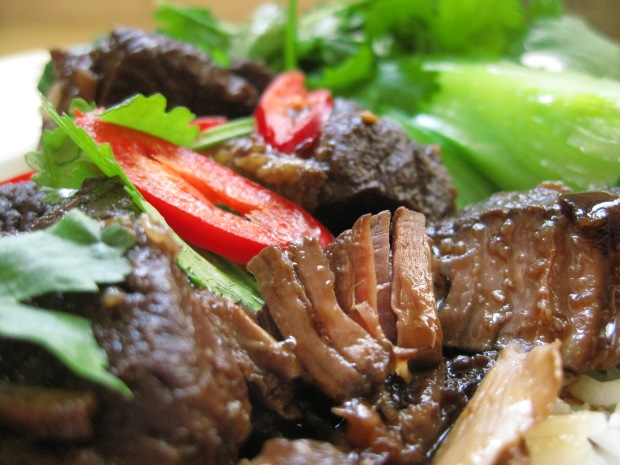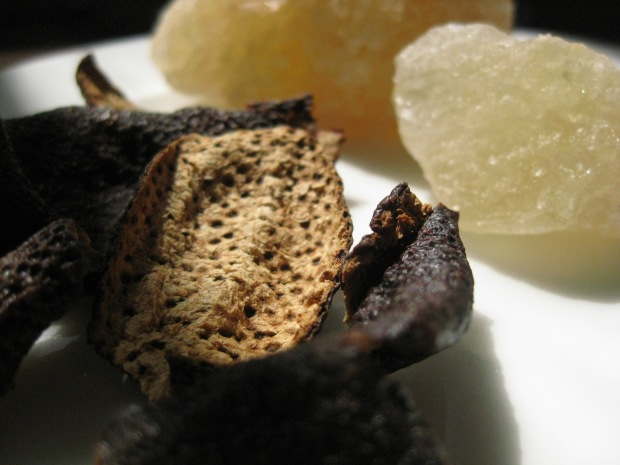A Chinese master stock is poaching or braising liquid which can be used over and over again. Over time, the flavour intensifies and like a mother dough, becomes more complex and full bodied. Master stocks are a very common Cantonese Chinese cooking technique. It comprises of water, soy sauce, Chinese cooking wine and aromatics such as ginger, star anise, cassia bark, garlic and dried tangerine peel.

The exact ingredients of a master stock is quite individual and I adjust ingredients or proportions depending on what I’m going to poach or braise. There’s a few garlic cloves in the recipe below but if I was cooking a chicken or a duck then I would probably omit the garlic, nor add so much tangerine peel. The dried peel goes fantastically with beef though so this time, into the pot it goes! Many recipes include Shaoxing, the Chinese cooking rice wine but I don’t. If you want to, add 50ml of the wine to the post along with the other liquid ingredients. You don’t have to cook meat in it either – shitake mushrooms, cooked peeled eggs and tofu are other master stock poaching options.

Apart from the beef, the star of this brisket is the dried tangerine peel. The flavour of of the peel is fragrant and faintly bitter in that way that citrus pith often is. In a pinch, you can substitute in fresh tangerine/mandarin/orange peel although it isn’t the same as the real thing. You can purchase dried tangerine peel from Asian grocery stores and also Chinese stores that specialise in certain smallgoods like dried scallop, abalone, shitake mushrooms etc. Aged before being sold, the older the peel, the better the flavour is reputed to be. I sourced my tangerine peel from my lovely mother so my secret stash is over 20 years old and very aromatic.
Chinese rock sugar add a lovely sheen and adds sweetness to master stock. I often use rock sugar when making Chinese sweet dessert soups or a simple ginger syrup to drizzle on sweet dumplings or a fruit salad. Rock sugar has a pale caramel or honey tones so it’s less one note than white sugar, although I think you can use raw caster sugar instead.
As most people don’t use master stock on a daily basis, it’s best kept in the freezer otherwise you have to boil every 3-4 days and who has time for that? Having a master stock on hand is a ‘pantry’ staple that means you can whip up a fantastic meal anytime. The braising liquid quantity is on the small side as master stocks go – you can easily double or triple the liquid ingredients but take it easy on the star anise and tangerine peel and just add an extra piece or two otherwise it’ll overwhelm.

Although it seems like a fair amount of chilli, even the higher amount specified below will only give a mild hint of heat. I recommend braising the meat on the bone so if you don’t like the bone factor, remove it at the end when the meat is tender. That way, you still get all the flavour benefits. If you cook the beef the day before, keep it overnight in the fridge so you can remove the solidified fat the next day. Like a good curry, it only tastes better if made earlier anyway! This recipe make quite a lot so I gifted some to a friend and portioned the rest into the freezer for future meals. To keep the master stock, strain after using and freeze.
I like to have my braised beef with a scoop of steamed rice and some green vegetables like bok choy or gai lan (Chinese kale). Some of the master stock was reduced down to a light glaze that’s drizzled over just before serving. I sliced some fresh chilli and picked off some fresh coriander leaves and dinner was done.
Feeds: Eight people (with vegetables and rice on the side)
Start cooking: At least 3 hours before eating (even better if prepared the day before)
Master stock braised beef brisket
Ingredients:
- 3 kilos x beef brisket (or other stewing cut), cut into 4cm pieces – this weight assumes bone-in
- 1 litre x water
- 200ml x light soy sauce
- 50ml x dark soy sauce
- 50-80 grams x Chinese yellow rock sugar (can substitute raw caster sugar)
- 3 pieces x dried tangerine peel
- 1 x fat man’s thumb sized piece of fresh ginger, sliced into 8mm pieces
- 2 x garlic cloves
- 1-2 x star anise
- 1 x cinnamon stick
- 20 x whole black peppercorns, lightly crushed
- 4-8 small chillis (fresh or dried)
- 2 x spring onions
- Salt, to taste
Method:
- Boil two litres of water in a large pot. Once boiling, add the beef brisket and bring back to the boil and blanch for 5 minutes.
- Drain the beef brisket and rinse under cold water. It is now ready to be braised.
- Prepare the master stock by placing remaining ingredients in a large pot. Simmer over medium heat for 10 minutes.
- Add the beef, bring to a simmer and cook for 90 minutes.
- Test the beef after 90 minutes. It should be tender at this point. If not yet tender, cook for a further 15 minutes or until tender.
- Do a taste test and adjust seasoning; it may need some added salt. Remember that we will reduce some of the master stock to create a light glaze so the flavour will intensify.
- If you have time, cool the braised brisket overnight in the fridge. The next day, skim off the solidified fat and reheat to serve.
- To create a sauce, place two cups of the braising liquid in a small saucepan and simmer over medium heat until reduced to a scant cup. It won’t be thick but will create a light glaze to drizzle over the brisket.
- Serve with steamed rice and simple greens. Add sliced chilli and fresh coriander (cilantro) if desired.